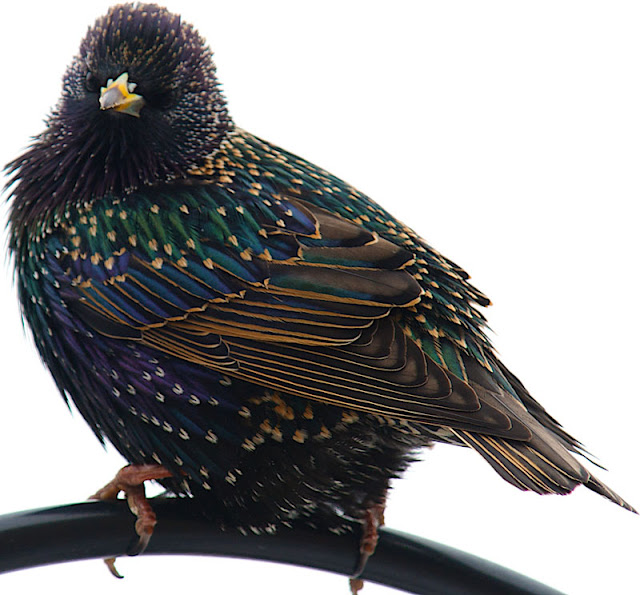Our winter starlings have started visiting our feeders. (
Oh, boy...right?) Actually, it's quite exciting when a flock descends on the yard. Hundreds and hundreds of birds swirl about squawking, scolding, and fighting...tree branches drip with the little feathered beasts, and I can hear them tapping across the gutters and on the roof. They bring in a lot of energy. Unfortunately, they eat up a lot of sunflower seeds, and they wreak havoc on the less rowdy birds that usually hang out. We have starlings year round, but they only become a nuisance during the winter when the ground is frozen. During the spring, summer and fall they keep to the ground, using their sharp bills to dig in the yard and root out grubs. They only get a little "beastly" during the winter...
 |
| I'm back, so you better get used to me! |
When you step back from the “ucky stuff” they do, European Starlings are striking. Up close you can see their beauty, and they actually do a lot of good on the insect front. Invertebrates are their primary food source, and when bugs are available, European Starlings really do prefer Japanese Beetles to sunflower seeds...
 |
| Don't hate me because I'm beautiful... |
 |
Grumpy, Grumpier...and Grumpiest
There are no Japanese Beetles in winter, and the June Bug grubs have burrowed beneath the frost line, so what's a starling to do? Be grumpy...and eat all of the sunflower seeds! |
When the sun highlights their iridescent colors, they really are eye catching, but unless you look closely, you might not see it. Additionally, in the winter, their feathers are fresh and new, which adds a beautiful speckled pattern. By summer the speckling has worn off...



...another bit of beauty starlings add to the world is their incredible winged ballet. A huge night-time starling roost is about
a mile from our house, so in the early evenings of winter, we get to witness this spectacle…swirls and turns, a giant black cloud that moves at incredible angles quickly and without pattern...it makes me stop and stare every time I see it.
Click here for a video from England that shows an example of this incredible sight.
Click here for a post titled
"How do Starling Flocks Create Those Mesmerizing Murmurations?" on Cornell's Round Robin blog by Andrea Alfano detailing these murmurations.
 |
| ...so while the ground remains frozen and covered with snow, we will probably always be a daytime roost for one of the flocks of starlings from our neighborhood night-time roost. |
I always try to remember that with the bad comes the good. We don't use pesticides on our lawn, so in the summer, starlings go to work for us. They are great at aerating the soil by digging up White Grubs (the larval stage of "June Bugs"), Sod Webworms, and other juicy invertebrates, which helps keep our lawn healthy. The US Department of Agriculture's Farmer's Bulletin (1928) No1571 reports,
"The starling is one of the most effective bird enemies of terrestrial insect pests in this country. More than half (57 percent) of the annual food of the adult starling consists of animal matter, including insects, millipedes, spiders, mollusks, a few crustaceans, and bits of suet and carrion." For more on the diet of the European Starling,
click here. To learn more about night-time roosts and starling behavior,
click here.
Happy Birding!
Kelly




















![[hearts4haiti.jpg]](https://blogger.googleusercontent.com/img/b/R29vZ2xl/AVvXsEiR9SO6u-jda6cIObjXGgHn_-oPbMiv2RBL8ZJ0aRwl2G-68rkPzT2fPcghgoye5eiVWD5_rFaC60yxvtwgjC1wKPb38tfkwxAaTmmP68FFNQoPCCpigcUX6Qoa4lgdwCtxE0XXywNjXSk/s1600/hearts4haiti.jpg)









































